MP Board Class 12th Chemistry Solutions Chapter 8 The d-and f-Block Elements
The d-and f-Block Elements NCERT Intext Exercises
Question 1.
Silver atom has completely filled d-orbitals (4d10) in its ground state. How can you say that it is a transition element?
Answer:
Silver exhibits +2 oxidation state. In this state, 4d- sub-shell contains nine electrons i.e., one of the 4d-orbitals is partially filled. Hence, it can be regarded as transition element.
Question 2.
In the series Sc (Z = 21) to Zn (Z = 30), the enthalpy of atomisation of Zinc is the lowest, i.e., 126 kj mol-1. Why ?
Answer:
In case of Zinc, 3d-electrons are not involved in metallic bonding, due to having 3d10 configuration. Because of poor metallic bonding, the enthaply of atomisation of Zinc is lowest.
Question 3.
Which of the 3d series of the transition metals exhibits the largest number of oxidation state and why ?
Answer:
Mn (Z = 25) exhibits the largest number of oxidation state, because it has the maximum number of unpaired electrons. Hence, it shows oxidation states from +2 to +7.
Question 4.
The E° (M2+/M) value for copper is positive (+0.34V). What is possibly the reason for this? (Hint: Consider its high ∆0H°Θ and low ∆hydH°).
Answer:
E°(M+2/M) for any metal depends upon the sum of enthalpies of atomisation, ionisation enthalpy and hydration enthalpy. Copper has high enthalpy of atomisation and low hydration enthalpy. Hence, E°(Cu+2/Cu) is positive.
Question 5.
How would you account for the irregular variation of ionisation enthalp-ies (first and second) in the first series of the transition elements?
Answer:
Irregular variation of ionisation enthalpies (first and second) is mainly due to varying degree of stability of different 3d-configurations. d0, d5 and d10 configurations have extra stability and hence in such cases the value of ionisation enthalpies are usually high.
For example, Cr has low first ionisation enthalpy because the electron has to be removed from 4s-orbital but the second ionisation enthalpy is very high as Cr+ has a stable d5 configuration. Zn has very high first ionisation enthalpy because electron is to be removed from stable configuration 3d10 4s2.
Question 6.
Why is the highest oxidation state of a metal exhibited in its oxide or fluo-ride only?
Answer:
Both.oxygen and fluorine are highly electronegative. Thus, they oxidise the met¬als in their compounds in highest oxidation state.
Question 7.
Which is a stronger reducing agent Cr2+ or Fe2+ and why ?
Answer:
Cr+2 is stronger reducing agent than Fe+2. This is because the configuration of Cr+2 changes from d4 to d3 and d3 configuration is stable (t32g) beinghalf filled t2g level.
Question 8.
Calculate the ‘spin only’ magnetic moment of M2+(aq) ion (Z = 27).
Answer:
The electronic configuration of M+2 (Z = 27) is

Question 9.
Explain why Cu+ ion is not stable in aqueous solutions?
Answer:
Cu+(aq) is not stable in aqueous solution because of its less negative enthalpy of hydration than Cu+2(aq).
Question 10.
Actinide contraction is greater from element to element than lanthanide contraction. Why?
Answer:
This is due to poor shielding effect by 5f electrons in the actinoids than that of 4f electrons in the lanthanoids.
![]()
The d-and f-Block Elements NCERT TextBook Exercises
Question 1.
Write down the electronic configuration of:
(i) Cr3+
(ii) Pm3+
(iii) Cu+
(iv) Ce4+
(v) CO2+
(vi) Lu2+
(vii) Mn2+
(viii) Th4+
Answer:
(i) Cr3+: [Ar]3d3
(ii) Pm3+ : [Xe]4f4
(iii) Cu+ : [Ar]3d10
(iv) Ce4+ : [Xe]54
(v) CO2+ : [Ar]3d7
(vi) LU2+ : [Xe]4f14 5d1
(vii) Mn2+ : [Ar]3d5
(viii) Th4+ : [Rn].
Question 2.
Why are Mn2+ compounds more stable than Fe2+ towards oxidation to their +3 oxidation state?
Answer:
Mn+2 has stable electronic configuration [Ar]4s03d5 and they do not easily change to Mn+3, Fe+2 [Ar] 4s03d6 on oxidation forms Fe+3 [Ar] 4s03d5 a more stable configuration.
Question 3.
Explain briefly how +2 oxidation state becomes more and more stable in the first half of the first row transition elements with increasing atomic number?
Answer:
Except Scandium (which shows an oxidation state of +3) all other first row transition elements show an oxidation state of +2. This is due to loss of two ns electrons. In the first half, as we move from Ti+2 to Mn+2 the electronic configuration changes from 3d2 to 3d5 i.e., more and more of d-orbitals are half filled imparting greater and greater stability of +2 oxiation state.
Question 4.
To what extent do the electronic configurations decide the stability of oxi-dation states in the first series of the transition elements? Illustrate your answer with examples.
Answer:
In transition series, the oxidation states which lead to exactly half filled or completely filled d-orbitals are more stable. For example, the electronic configuration of Fe(Z = 26) is [Ar] 3d64s2. It shows various oxidation states but Fe (III) is most stable because it has the configuration [Ar]3d5.
Question 5.
What may be the stable oxidation state of the transition element with the following d electronic configurations in the ground state of their atoms : 3d3,3d5,3d8 and 3d4?
Solution:
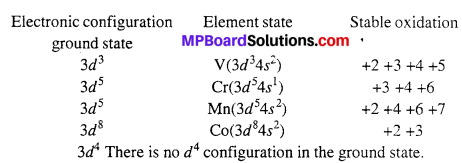
Question 6.
Name the oxometal anions of the first series of the transition metals in which the metal exhibits the oxidation state equal to its group number.
Answer:
Cr2O72- and CrO42- (Group No. = Oxidation state of Cr = 6), MnO4 (Group No. = Oxidation state of Mn = 7).
Question 7.
What is lanthanoid contraction? What are the consequences of lanthanoid contraction?
Answer:
Interesting feature of the atomic size of lanthanides is that on moving down the group steady decrease in atomic size is observed. The shape of f-orbital is in such a way that its shielding effect is minimum, therefore on addition of extra electron in f-subshell only attractive force increases. The steady decrease (contraction) in size of fourteen lanthanide elements (La3+ 1 06Å to Lu3+ 0.8Å) by a value of about 0.2Å is known as lanthanide contraction.
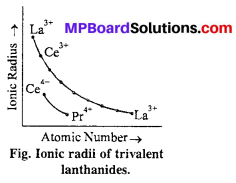
Reason : (i) The new electrons in lanthanides instead of going to outermost shell enters (n-2)f- suborbital as a result of which force of attraction increases between electron and nucleus due to which atom or ion contracts.
(ii) Electron entering in (n-2)f- suborbital have negligible or zero shielding effect over electrons present in the last orbit. In addition the shape of f-suborbital is not favourable for the shielding effect of electrons. Thus, lanthanide contraction occur.
Consequences of lanthanide contraction :
(i) Change in the properties of lanthanides: Due to lanthanide contraction, little change occurs in the properties of lanthanides. So it is very difficult to obtain them in pure state.
(ii) Influence over the properties of other elements : Lanthanide contraction have an important influence over the element present before and after it e.g., there is difference in properties of Ti and Zr while Zr and Hf have similar properties.
Question 8.
What are the characteristics of the transition elements and why are they called transition elements? Which of the d-block elements may not be regarded as the transition elements?
Answer:
Transition elements are those elements in which the atoms or ions (in stable oxidation state) contain partially filled cf-orbital. These elements lie in the p-block and show a transition of properties between 5-block and p-block. Therefore, these are called transition elements. Elements such as Zn, Cd and Hg cannot be classified as transition elements be¬cause these have completely filled d-subshell.
Question 9.
In what way is the electronic configuration of the transition elements different from that of the non-transition elements?
Answer:
The transition elements involve the filling of d-orbitals while the representative elements involve the filling of s and p-orbitals. The general electronic configuration of transition element is (n-1)d1-10 ns1-2 on the other hand, the general electronic configuration of representative elements in ns1-2 or ns2 np1-6. Thus, in representative elements only the last shell is incomplete while in transition elements the last but one shell is also incomplete.
Question 10.
What are the different oxidation states exhibited by the lanthanoids?
Answer:
The principal oxidation state of lanthanoids is +3. In addition, they exhibit oxi-dation states of +2 and + 4.
Question 11.
Explain giving reasons:
(i) Transition metals and many of their compounds show paramagnetic behaviour.
(ii) The enthalpies of atomisation of the transition metals are high.
(iii) The transition metals generally form coloured compounds.
(iv) Transition metals and their many compounds act as good catalyst.
Answer:
(i) Paramagnetic substance is one which is attracted by magnetic field. It arises due to presence of unpaired electron in atom, ion or molecule.
Most of the transition elements and compounds are paramagnetic in nature. This is due to fact that transition elements involve partially filled 4 subshell and their atom and ion contain unpaired electron.
(ii) Transition elements have high effective nuclear charge and a large number of valence electrons. Therefore, they form very strong metallic bonds. As a result, the enthalpy of atomization of transition metals is high.
(iii) The colour of transitional metal ions is due to partially filled (n-1)d orbitals. In transitional metal ions which contain unpaired d electrons, transition of electrons takes place from one 4-orbital to another 4-orbital. During this transition it absorbs some radiation of visible light and reflects the remaining radiation in the form of coloured light. Thus, the colour of the ion is complementary to the colour absorbed by it.
For example: [Cu(H2O)6]2+ ion appears blue because it absorbs the red colour of the visible light for electron promotion and reflects its complementary blue colour.
Colour of some ions :

(iv)Transition elements act as good catalysts in chemical reaction in the hydrogenation of Ni metal, in contact process of manufacture of SO3, Pt and in manufacture of NH3 by Haber process Fe acts as catalyst. In the method of preparation of O2 by heating KClO3, MnO2 acts as catalyst.
Question 12.
What are interstitial compounds? Why are such compounds well known for transition metals?
Answer:
Most of the Transition elements form interstitial compounds at high temperature with atoms of non-metallic elements like-H,B,C,N, Si etc. Small atoms of these non-metal- lic elements fit in the interstitial voids of crystal lattice of transition elements. These are called interstitial compounds.
Properties :
- Properties of these compounds are like parent metal but physical properties differ.
- These compounds are hard.
- Their ductility and malleability becomes less.
- Their electrical conductivity decreases.
Example: TiH, NiH2.
![]()
Question 13.
How is the variability in oxidation states of transition metals different from that of the non-transition metals? Illustrate with examples.
Answer:
In transition elements, the successive oxidation states differ by unity. For ex-ample, Mn shows all the oxidation states from + 2 to +7. On the other hand, non-transition metals exhibit variable oxidation states which differ by two units. For example Pb(II), Pb(IV), Sn(II), Sn(IV).
Question 14.
Describe the preparation of potassium dichromate from iron chromite ore. What is the effect of increasing pH on a solution of potassium dichromate?
Answer:
Preparation : It is prepared from chromite ore or ferrochrome of chrome iron FeCr2O4 (FeO.Cr2O3). Different steps involved in the process are as follows :
1. Preparation of sodium chromate : The ore is finely powdered, mixed with sodium carbonate and quick lime and then roasted (heated to redness) in a reverberatory furnace in presence of excess of air when sodium chromate (yellow in colour) is formed with the evolution of CO2. Quick lime is added to keep the mass porous and thus facilitates oxidation.

The roasted mass is extracted with water when sodium chromate dissolves completely leaving behind ferric oxide.
2. Conversion of sodium chromate to sodium dichromate : Sodium chromate is extracted with water and acidified with sulphuric acid to get sodium dichromate.
2Na2CrO4 + H2SO4 → Na2Cr2O7 + Na2SO4 + H2O
On concentration the less soluble sodium sulphate Na2SO4.10H2O crystallizes out. This is filtered hot and allowed to cool when sodium dichromate Na2Cr2O7.2H2O separates on standing.
3. Conversion of sodium dichromatic into potassium dichromate : Hot concentrated solution of sodium dichromate is treated with requisite amount of potassium chloride when potassium dichromate being less soluble crystallizes out on cooling.
Na2Cr2O7 + 2KCl → K2Cr2O7 + 2NaCl
Effect of pH on a solution of K2Cr2O7: Potassium chloride being less soluble than sodium chloride is obtained in the form of orange coloured crystals and can be removed by filtration. The dichromate ion \(\mathrm{Cr}_{2} \mathrm{O}_{7}^{2-}\) exists in equilibrium with chromate \(\mathrm{Cr}_{2} \mathrm{O}_{4}^{2-}\) ion at pH 4. However, by changing the pH, they can be interconverted.

Question 15.
Describe the oxidising action of potassium dichromate and write the ionic equations for its reaction with:
(i) Iodide
(ii) Iron(II) solution and
(iii) H2S.
Answer:
Reaction of K2Cr2O7 with acidic FeSO4, KI and H2S :
K2Cr2O7 acts as a very strong oxidizing agent in the acidic medium.
K2Cr2O7 + 4H2SO4 → K2SO4 + Cr2 (SO4)3 + 4H2O + 3[O]
K2Cr2O7 takes up electrons to get reduced and acts as an oxidizing agent. The reaction K2Cr2O7 with other iodide, iron (II) solution, and H2S are given below :
(i) It oxidizes ferrous sulphate to ferric sulphate.

(ii) It liberates I2 from KI.

These reactions are used in the estimation of iodine and ferrous ion in volumetric analysis
(iii) It oxidizes SO2 to sulphuric acid.

(iv) It oxidizes H2S to sulphur.

![]()
Question 16.
Describe the preparation of potassium permanganate. How does the acidi-fied permanganate solution react with (i) Iron(II) ions (ii) SO2 and (iii) Oxalic acid ? Write the ionic equations for the reactions.
Answer:
Preparation : Potassium permanganate is prepared from manganese dioxide. On a large scale, it is prepared from the mineral pyrolusite. The process involves the following steps:
1. Conversion of MnO2 into potassium manganate : The finely powdered pyrolusite mineral is fused with potassium carbonate or potassium hydroxide in presence of atmospheric oxygen or an oxidising agent such as potassium nitrate or potassium chlorate. The fused mass turns green due to the formation of potassium manganate.
2MnO2 + 2K2CO3 + O2 → 2K2MnO4 + 2CO2
2MnO2 + 4KOH + O2 → 2K2MnO4 + 2H2O
MnO2 + 2KOH + KNO3 → K2MnO4 + KNO2 + H2O
3MnO2 + 6KOH + KCl1O3 → 3K2MnO4 + KCl + 3H2O
2. Oxidation of potassium manganate into potassium permanganate :
(i) Chemical oxidation : The fused mass is extracted with water and the solution is filtered. The green solution is then converted to potassium permanganate by bubbling carbon dioxide, chlorine or oxygen through it.
32MnO4 + 2CO2 → 2KMnO4 + MnO2 ↓+ 2K2CO3
2K2MnO4 + Cl2 → 2KMnO4 + 2KCl
2K2MnO4 + H2O + O3 → 2KMnO4 + 2KOH + O2
The purple solution of potassium permanganate thus obtained is concentrated when it deposits dark purple, needle like crystals having a metallic lustre.
(ii) Electrolytic oxidation : Nowadays, it is largely manufactured by the electrolytic oxidation of the manganate. The manganate solution is electrolysed between iron electrodes separated by diaphragm. The oxygen evolved at the anode converts manganate to permanganate.

After the oxidation is completed, the solution is filtered and evaporated under controlled condition to obtain the crystals of potassium permanganate.
(i) Acidified KMnO4 solution oxidizes Fe(II) ions to Fe(III) ions i.e. ferrous ions to ferric ions.

(ii) Acidified potassium permanganate oxidizes SO2 to sulphuric acid.

(iii) Acidified potassium permanganate oxidizes oxalic acid to carbon dioxide.

![]()
Question 17.
For M2+/M and M3+/M2+ systems the E° values for some metals are as follows:
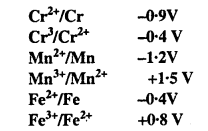
Use this data to comment upon:
(i) The stability of Fe3+ in acid solution as compared to that of Cr3+ or Mn3+ and
(ii) The ease with which iron can be oxidised as compared to a similar process for either chromium or manganese metal.
Answer:
(i) As E° Cr+3/Cr+2 is negative (-0.4V), this means Cr+3 ion in solution cannot be reduced to Cr+2 easily, i.e., Cr+3 ions are very stable. As E° M+3/ Mn+2 is positive (+ 1.5V), Mn+3 ions can easily be reduced to Mn+2 ions in comparison to Fe+3 ions. Thus, the relative stability of these ions is:
![]()
(ii) Oxidation potentials for the given pairs will be +0-9V, + 1-2V and 04V. Thus, the order of their getting oxidised will be in the order Mn > Cr > Fe.
Question 18.
Predict which of the following will be coloured in aqueous solution? Ti3+, V3+, Cu+, Sc3+, Mn2+, Fe3+ and CO2+. Give reasons for each.
Answer:
The ions with one or more unpaired electrons will be coloured in aqueous solu-tion due to d-d transition.
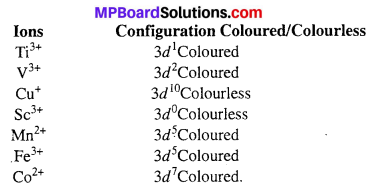
Question 19.
Compare the stability of +2 oxidation state for the elements of the first transition series.
Ans.
The stability of +2 oxidation state decreases from left to right except for Mn and Zn. Stability decreases towards right due to decreasing negative value of standard reduction potential. The decrease in the -ve value of E° is due to increase in sum of ∆i H1 + ∆iH2 (first and second ionisation enthalpy)
Question 20.
Compare the chemistry of actinoids with that of the lanthanoids with special reference to:
(i) Electronic configuration
(ii) Atomic and ionic sizes
(iii) Oxidation state and
(iv) Chemical reactivity.
Answer:
Differences between Lanthanoids and Actinoids :
Lanthanoids
- Differentiating or last electrons enter in 4 f-sub-shell of (n – 2) orbit.
- These elements come after lanthanum so these are called lanthanoids.
- Common oxidation state is +3, other oxidation states are +2 and +4 also.
- Atomic or ionic radius decreases gradually and this is called lanthanide contraction.
- Lanthanoids have smaller tendency to form complexes.
- Lanthanoids do not form oxo-ions.
- Compounds of lanthanoids exhibit less basic in nature.
- Lanthanoids are not radioactive except Promethium.
- Except Pm, other lanthanoids are present in nature in abundance comparatively more than iodine.
Actinoids
- Differentiating or last electrons enter in 5f-sub-shell of (n – 2) orbit.
- These elements come after actinium so these are called actinoids.
- Common oxidation state in actinoids is also +3 but other oxidation states are higher, e.g., +4, +5, +6 and +7.
- Atomic or ionic radius also decreases gradually and steadily and this is called actinoid contraction.
- Actinoids have comparatively higher tendency of complex formation.
- Oxo-ions are formed, e.g., UO+2, PuO+2, UO+, etc.
- Compounds of actinoids are more basic in nature.
- All the actinoids are radioactive.
- Most of these are not found in nature and are artificially prepared.
Question 21.
How would you account for the following:
(i) Of the d4 species, Cr2+ is strongly reducing while manganese(III) is strongly oxidising.
(ii) Cobalt(II) is stable in aqueous solution but in the presence of complexing reagents it is easily oxidised.
(iii) The d1 configuration is very unstable in ions.
Answer:
(i) Cr+2 is reducing in nature as its configuration changes from d4 to d3 (A stable configuration having half filled t28 orbitals). On the other hand, Mn+3 is oxidising in nature as the configuration changes from d4 to d5 (A stable configuration having half filled t2g to eg orbitals)
(ii) Strong ligands force Cobalt (II) to lose one more electron from 3cfsubshell and thereby induce d2sp3-hybridisation.
(iii) The ions with d1 configuration try to lose the only electron on d-subshell in order to acquire stable inert gas configuration.
Question 22.
What is meant by ‘disproportionation’? Give two examples of dispropor-tionation reaction in aqueous solution.
Answer:
The disproportionation reactions are those in which the same substance get oxidised as well as reduced, for example

Question 23.
Which metal in the first series of transition metals exhibits +1 oxidation state most frequently and why?
Answer:
Copper has electronic configuration [Ar] 3d104s1. It can easily lose one (4s1) electron to give stable 3d10 configuration.
![]()
Question 24.
Calculate the number of unpaired electrons in the following gaseous ions: Mn3+, Cr3+, V3+ and Ti3+. Which one of these is the most stable in aqueous solution?
Answer:

Cr+2 is most stable as it has half filled t28 level.
Question 25.
Give examples and suggest reasons for the following features of the transition metal chemistry:
(i) The lowest oxide of transition metal is basic, the highest is amphoteric/acidic.
(ii) A transition metal exhibits highest oxidation state in oxides and fluorides.
(iii) The highest oxidation state is exhibited in oxo-anions of a metal.
Answer:
(i) The lowest oxide of transition metal is basic because the metal atom has low oxidation state whereas highest is acidic or amphoteric due to highest oxidation state. For

In low oxidation state of the metal, some of the valence electrons of the metal atom are not involved in bonding. Hence, it can donate electrons and behave as a base. In the higher oxidation state, valence electrons are involved in the bonding and are not available. Instead, effective nuclear charge is high. Hence, it can accept electrons and hence behave as an acid.
(ii) A transition metal exhibits higher oxidation states in oxides and fluorides because oxygen and fluorine are of small size and high electronegativity and hence can readily oxidise metals, for example OsF6[Os(VI)], V2O5[V(V)].
(iii) Oxo-anions of metals have highest oxidation states, for example Cr in Cr2O2-7 has an oxidation state of +6 whereas Mn in MnO–4 has an oxidation state of +7. This is because of high electronegativity of oxgyen and is high oxidising property.
Question 26.
Indicate the steps in the preparation of:
(i) K2Cr2O7 from chromite ore
(ii) KMnO4 from pyrolusite ore.
Answer:
(i) It oxidizes ferrous sulphate to ferric sulphate.

(ii) Acidified KMnO4 solution oxidizes Fe(II) ions to Fe(III) ions i.e. ferrous ions to ferric ions.

Question 27.
What are alloys ? Name an important alloy which contains some of the lanthanoid metals. Mention its uses.
Answer:
An alloy is a homogeneous mixture of two or more metals or metals and non-metals. An important alloy contains lanthanoid metal is mischmetal which contains 50% Cerium and 25 % Lanthanum, with small amounts of Nd (Neodymium) and Pr (Praseody-mium). It is used in Mg-based alloy to produce bullets, shell and lighter flints.
Question 28.
What are inner transition elements ? Decide which of the following atomic numbers are the atomic numbers of the inner transition elements : 29,59,74,95,102, 104.
Answer:
The f-block elements i.e., in which last electrons into antipenultimate f-subshell are called inner-transition elements. These include lanthanoids (58-71) and actinoids (90-103). Thus, elements with atomic numbers 59,95 and 102 are inner transition elements.
Question 29.
The chemistry of the actinoid elements is not so smooth as that of the lanthanoids. Justify this statement by giving some examples from the oxidation state of these elements.
Answer:
Lanthanoids show limited number of oxidation states, such as +2, +3 and +4 (+3 is the principal oxidation state). This is because of large energy gap between 5d and 4f- subshells. On the other hand, actinoids also show principal oxidation state of +3 but show a number of other oxidation state also. For example, Uranium (Z = 92) exhibits oxidation states of +3, +4, +5, +6 and Neptunium (Z = 94) shows oxidation states of +3, +4, +5, +6 and +7. This is because of small energy difference between 5f and 6d orbitals.
Question 30.
Which is the last element in the series of the actinoids ? Write the electronic configuration of this element. Comment on the possible oxidation state of this element.
Answer:
Last element of the actinoid series = Lawrencium (Z = 103)
Electronic configuration = [Rn] 5f14 6dl1 7s2 Possible oxidation state = +3.
Question 31.
Use Hund’s rule to derive the electronic configuration of Ce3+ ion, and calculate its magnetic moment on the basis of ‘spin-only’ formula.
Answer:
Cerium electronic configuration = [Xe]4f1 5d1 16s2
Ce+3 ion = [Xe]4f1
i.e., one unpaired electron is present
Magnetic moment, µ = \(\sqrt{n(n+2)}\)
= \(\sqrt { 3 }\) = 1.73BM.
Question 32.
Name the members of the lanthanoid series which exhibit +4 oxidation states and those which exhibit +2 oxidation states. Try to correlate this type of behaviour with the electronic configurations of these elements.
Answer:
+4 = 58Ce, 59Pr 60Nd 65Tb 66Dy
+2 = 60Nd 62Sm 63EU 69Tm 70Yb.
+4 oxidation state is shown when the configuration left is close to either 4f0 (i.e., 4f0 4f1 4f2) or close to 4f0 (i.e.,4f0 4f1 4f2) or close to 4f2 (i.e., 4f7 or 4f8) +2 oxidation state is shown when the configuration is 5d° 6s2 so that two electrons are easily lost.
Question 33.
Compare the chemistry of the actinoids with that of lanthanoids with reference to:
(i) Electronic configuration
(ii) Oxidation states and
(iii) Chemical reactivity.
Answer:
Lanthanoids
- Differentiating or last electrons enter in 4 f-sub-shell of (n – 2) orbit.
- These elements come after lanthanum so these are called lanthanoids.
- Common oxidation state is +3, other oxidation states are +2 and +4 also.
- Atomic or ionic radius decreases gradually and this is called lanthanide contraction.
- Lanthanoids have smaller tendency to form complexes.
- Lanthanoids do not form oxo-ions.
- Compounds of lanthanoids exhibit less basic in nature.
- Lanthanoids are not radioactive except Promethium.
- Except Pm, other lanthanoids are present in nature in abundance comparatively more than iodine.
Actinoids
- Differentiating or last electrons enter in 5f-sub-shell of (n – 2) orbit.
- These elements come after actinium so these are called actinoids.
- Common oxidation state in actinoids is also +3 but other oxidation states are higher, e.g., +4, +5, +6 and +7.
- Atomic or ionic radius also decreases gradually and steadily and this is called actinoid contraction.
- Actinoids have comparatively higher tendency of complex formation.
- Oxo-ions are formed, e.g., UO+2, PuO+2, UO+, etc.
- Compounds of actinoids are more basic in nature.
- All the actinoids are radioactive.
- Most of these are not found in nature and are artificially prepared.
Question 34.
Write the electronic configurations of the elements with the atomic num-bers 61, 91,101, and 109.
Answer:
(i) Z = 61 : [Xe] 4f5 5d0 6s2
(ii) Z = 91 : [Rn] 5f2 6d1 7s2
(iii) Z = 101 : [Rn] 5f13 6d0 7s2
(iv) Z = 109 : [Rn] 5f14 6d7 7s2
Question 35.
Compare the general characteristics of the first series of the transition metals with those of the second and third series metals in the respective vertical columns. Give special emphasis on the following points:
(i) Electronic configurations
(ii) Oxidation states
(iii) Ionisation enthalpies and
(iv) Atomic sizes.
Answer:
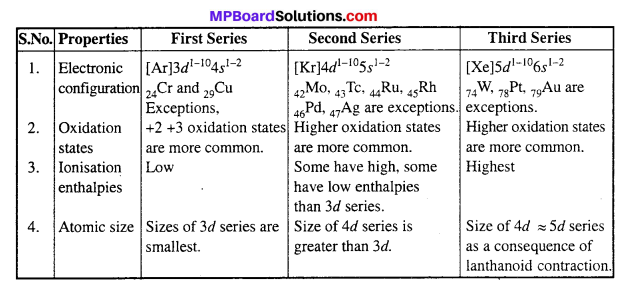
Question 36.
Write down the number of 3d electrons in each of the following ions: Ti2+, V2+, Cr3+, Mn2+, Fe2+, Fe3+, CO2+, Ni2+ and Cu2+. Indicate how would you expect the five 3d orbitals to be occupied for these hydrated ions (Octahedral).
Answer:
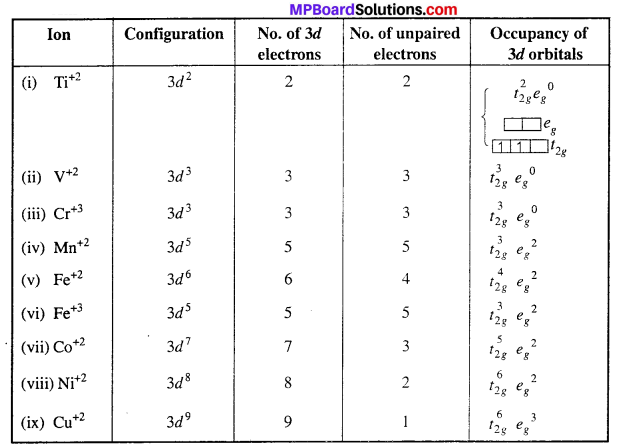
Note : About t2g and eg orbitals refer MOT Unit 9.
Question 37.
Comment on the statement that elements of the first transition series possess many properties different from those of heavier transition elements.
Answer:
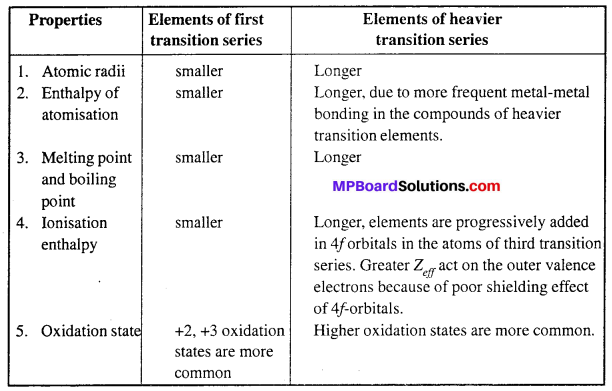
![]()
Question 38.
What can be inferred from the magnetic moment values of the following complex species ?

Answer:
K4[Mn(CN)6]
Mn+2 : 3d5, magnetic moment of 2.2 indicates that it has one unpaired electron and hence forms inner orbitals or low spin complex. Its configuration is: t52g.
[Fe(H2O)6]2+
Fe+2 : 3d6, the magnetic moment value is close to 4 unpaired electrons so it forms outer orbital complex having 4 unpaired electrons. Its configuration is : t2g 4eg2g.
K2[MnCl4]
Mn+2: 3d5, the magnetic moment corresponds to 5 unpaired electrons. The cZ-orbitals are not disturbed. So it forms tetrahedral complex. Its configuration is : t2g 3eg2
![]()
The d-and f-Block Elements Other Important Questions and Answers
The d-and f-Block Elements Objective Type Questions
Question 1.
Choose the correct answer :
Question 1.
In which of the compounds Mn shows highest oxidation state :
(a) K2MnO4
(b) KMnO4
(c) MnO2
(d) Mn3O4.
Answer:
(b) KMnO4
Question 2.
Which forms interstitial compound :
(a) Fe
(b) Ca
(c) Ni
(d) All of these
Answer:
(b) Ca
Question 3.
In neutral medium equivalent weight of KMnO4 is :
(a) M
(b) M/2
(c) M/3
(d) M/5.
Answer:
(c) M/3
Question 4.
The Lanthanide which is widely used :
(a) Lanthanum
(b) Nobelium
(c) Thorium
(d) Cerium.
Answer:
(d) Cerium.
Question 5.
Electronic configuration of Gadolinium is :
(a) [Xe] 4f6, 5d9, 6s2
(b) [Xe] 4f7, 5d1,6s2
(c) [Xe] 4f3, 5d5, 6s2
(d) [Xe] 4f6, 5d2, 6s2.
Answer:
(b) [Xe] 4f7, 5d1,6s2
Question 6.
Lanthanides contraction is responsible for the fact:
(a) 2r and Y have almost equal radius
(b) Zr and Nb have same oxidation state
(c) Zr and Hf have almost equal radius
(d) Zr and Zn have same oxidation state.
Answer:
(c) Zr and Hf have almost equal radius
Question 7.
In 3d series which elements shows highest oxidation state :
(a) Mn
(b) Fe2+
(c) Ni
(d) Cr.
Answer:
(a) Mn
Question 8.
Which of the transition metal ion is coloured :
(a) Cu+
(b) V2+
(c) Sc3+
(d) Ti4+.
Answer:
(b) V2+
Question 9.
A transition metal which is green in +3 oxidation state and orange in +6 oxidation state is:
(a) Mn
(b) Cr
(c) Os
(d) Fe.
Answer:
(b) Cr
Question 10.
In lanthanides the basicity of lanthanide oxides are :
(a) Increases
(b) Decreases
(c) First increases then decreases
(d) First decreases then increases.
Answer:
(b) Decreases
Question 11.
Number of unpaired electron in Fe+2 ion is :
(a) 0
(b) 4
(c) 6
(d) 3.
Answer:
(b) 4
Question 12.
Fe, Co, Ni, are magnetic substances of which type :
(a) Paramagnetic
(b) Ferromagnetic
(c) Diamagnetic
(d) Anti ferromagnetic.
Answer:
(b) Ferromagnetic
Question 2.
Fill in the blanks :
- Metals Fe, CO, Ni are known as ………………………
- Ionic size of trivalent cations are ……………………… with increase in atomic numbers.
- The transition metals having lower oxidation state shows ……………………… nature.
- K2Cr2O7 is a strong ……………………… agent, which gives ……………………… nascent oxygen.
- Zn shows only ……………………… oxidation state.
- f-block elements are known as ……………………… elements.
- Transition elements and their compounds act as ………………………
- General electronic configuration of inner transition element is ………………………
- Chemical form of Potassium manganate is ………………………
- f-block elements are also known as ………………………
Answers:
- Ferrous metals
- Decreases
- Basic
- Oxidising 3
- + 2
- Inner transition
- Catalyst
- (n-2)f1-14 (n-1)d1-2 ns2
- K2MnO4
- Transitional Elements.
Question 3.
Match the following :
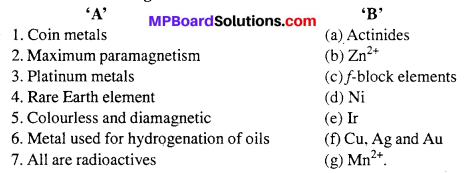
Answers:
- (f)
- (g)
- (e)
- (c)
- (b)
- (d)
- (a).
Question 4.
Answer in one word / sentence :
1. Which is colourless Cu2+ or Cu+?
2. In a reaction KMnO4 is replaced by K2MnO4 then what will be the change in oxidation state of Mn ?
3. Which series shows higher oxidation state lanthanides or actinides ?
4. Which oxidation state of lanthanum is most stable ?
5. Write the equivalent weight of K2Cr2O7 in acid medium.
6. How many unpaired electrons are present in Fe3+ ?
7. Give the name of oxidising agent used in chromyl chloride test.
8. Out of (7-block elements, Zn does not show variable valencies, why ?
9. Which is the most important oxidation state of Cu ?
10. f-block elements can be divided into how many series ?
11. What is Lunar caustic ?
12. In d-block elements Zn does not exhibit variable oxidation state. Why ?
13. What is the alkaline solution of HgCl2 and KI known as ?
Answers:
1. Cu+
2. 1
3. Actinides
4. +3
5. 49
6. 5
7. K2Cr2O7
8. Completely filled ‘d’orbitals
9. +2
10. 2
11. AgNO3 (Silver nitrate)
12. Due to fully filled d-orbitals
13. Nessler’s reagent.
![]()
The d-and f-Block Elements Short Answer Type Questions
Question 1.
Silver atom has completely filled d-orbitals (4d10) in its ground state. How can you say that it is a transition element ?
Answer:
Silver exhibits 4d105s0 electronic configuration in +1 oxidation state. But in some compounds it exhibits +2 oxidation state. In this state its electronic configuration is 4d95s0. Thus, due to incompletely filled 4d orbital, it is a transition element.
Question 2.
What are Transition elements ? They show metallic character. Why ?
Answer:
Elements whose atoms in their ground state or ions in their common oxidation states have incomplete or partially filled cf orbitals are called transitional elements. They are in group 2 to 13. Example : Fe, Ni, Co, etc.
General formula : (n-1)d1-10 ns1-2
Metallic character of an element depends on its tendency to form cation by loosing one or more electrons from its atom. All transitional elements are metals because they contain one or two electrons in their outermost shell which can be easily lost due to low ionisation energy. Thus, they are metallic in nature.
Question 3.
Why do transition metals exhibit variable oxidation states ?
Answer:
Transition metals exhibit variable valency because the energy subshell (n-1)d and ns are very close. Thus, possibility to lose electrons from ns subshell as well as from (n-1) d subshell is very much if there are unpaired electrons. So oxidation states of these metals may increase.
In these elements Mn shows maximum variable valencies.
Question 4.
Transition elements form alloy easily. Explain.
Answer:
It is the homogeneous mixture of two or more metals or metals with non-metals. Alloys are made to confer the property of metals. Transition elements have great tendency to form alloys because these elements have similar atomic size and can mutually substitute their positions in their crystal lattice. Alloys are comparatively hard and have higher m.p. than the elements from which they are made.
Question 5.
Explain magnetic properties of transitional elements on the basis of their electronic configuration.
Or,
Explain diamagnetism and paramagnetism.
Answer:
Magnetic property : Magnetic property is shown as:
(a) Paramagnetic substances: The substances which are attracted by magnetic field are called as paramagnetic substances. This property of paramagnetism is due to presence of unpaired electrons in atomic orbitals.
Fe, Co and Ni are ferromagnetic because they can be magnetised. Paramagnetism is represented by following formula :
\(\mu=\sqrt{n(n+2)}\)
Where, µ = Magnetic moment, n = Number of unpaired electrons.
(b) Diamagnetic substances : The substances which are repelled by magnetic field are called diamagnetic substances. In this type of substances all electrons are paired. Zinc is a diamagnetic metal.
Question 6.
Transition elements are inactive. Why ?
Answer:
The reason for low reactivity of transition elements are the following :
- High ionisation energy.
- High value of sublimation or atomization energy.
- Small value of hydration energy.
- Low value of standard electrode potential.
Question 7.
Write main characteristics of transitional elements.
Answer:
Main characteristics of transitional elements :
- Transition metals are metallic in nature which has electropositive character from Ti to Cu.
- They are hard and conductor of heat and electricity.
- Their b.p. and m.p. are high.
- They show variable oxidation states.
- These metals form coloured ions.
- These metals form co-ordination compounds.
- They are generally paramagnetic.
- These are good catalysts.
- These form alloys.
- These form interstitial compounds with non-metals.
Question 8.
Write any five main differences between d and f-Block elements.
Answer:
Differences between d and f-Block Elements :
d-Block Elements:
- Two shells n and (n-1) are incomplete.
- Last electron enters the d- orbital of penultimate shell.
- d-block elements are normally called Transitional element.
- d-block elements are available in nature.
- These elements exhibit variable oxidation state.
- These elements are stable.
f-Block Elements:
- Three shells n, (n-1) and (n-2) are inco-mplete.
- Last electron enters the orbital of antip-enultimate (n-2) shell.
- f-block elements are normally called Inner Transitional element.
- f-block elements are very rare. Therefore they are known as Rare Earth elements.
- These elements also exhibit variable oxidation state.
- These elements are less stable and many are radioactive.
Question 9.
What are Inner Transition elements ?
Answer:
These are the elements which contain (n-2)f and (n-1)d incomplete orbitals or in which electron enter in the antipenultimate (two energy levels below the outermost orbit orbital. These are so called because these are found within the transition elements. There are two types of inner transition elements :
(i) Lanthanides series : The 14 elements after Lanthanum (La57)
i. e., 58Ce – 71 LU are called lanthanides.
(ii) Actinides series : The 14 elements after Actinide (Ac89) i.e., Th90 to Lw103.
Question 10.
Write the name of members of Group 12. Why are they generally not considered as transition elements ?
Answer:
Members of Group 12 are Zn, Cd and Hg which are not included in transition elements because in both their atomic state and in bivalent ion state their electronic configuration is (n – 1)d10 i.e., their d-orbitals are completely filled. Therefore, they are not considered as transition elements.
Question 11.
Write any five characteristics of lanthanides.
Answer:
Five characteristics of lanthanides :
- These belongs tof-block because last electron goes to the f-subshell.
- These are shining metals like silver.
- These are good conductor of heat and electricity.
- Melting point and density of these are high.
- From La to Lu, atomic radii decreases continuously, it is called lanthanide contraction.
Question 12.
What is the reason that the ionisation energy of 5d series elements is higher than the series ?
Answer:
On moving from top to bottom in a group, value of ionisation energy decreases, but ionisation energy of elements of 5d series is higher than that of elements of 4d series. This is because of the presence of 14 Lanthanide elements in between due to which their size does not increase appreciably. Thus, attractive force between the nucleus and outermost electron is more and this is the cause of higher ionisation potential.
Question 13.
(i) Transition metals possess the ability, to form complex compounds. Explain.
(ii) Zn, Cd and Hg do not show the properties of Transition elements.
(iii) Why is Ti known as a wonder metal ?
Answer:
(i) Cause of formation of complex compounds by Transition metals :
(a) Small size of ions of these elements and high nuclear charge due to which these ions attract ligands.
(b) They possess vacant zforbitals in order to accomodate the electron pair donated by ligand.
(ii) Elements in which (n-1) d-orbital is partially filled are known as Transition elements.
Whereas in Zn [3d10 4s2], in Cd [4d10 5s2] and in Hg [5d10 6s2] state is found. Therefore, these do not show the properties of Transition elements.
(iii) Titanium is a shining white metal. It is extented strong (harder than steel), has high m.p. Good conductor of electric current resistant to corrosion and light metal. Due to all these qualities, it is called wonder metal.
Question 14.
The radius of Fe2+ ion is smaller than the radius of Mn2+ ion, why ?
Answer:
The atomic number of Fe (26) is more than the atomic number of Mn (25). Due to higher value of atomic number, iron nucleus contains more protons. Hence the force of attraction between the nucleus and the electrons of outermost orbit is more. Due to strong attractive force of the nucleus the electron cloud is pulled inwards which results in smaller size of Fe2+ ion as compared to Mn2+ ion.
Question 15.
Why is it difficult to separate lanthanide group ? Explain.
Answer:
The 14 inner transition elements which come after lanthanum (atomic number 57) are called lanthanides. In these elements, the incoming electrons enter in 4f – orbital leaving 5th and 6th orbital.
Separation of lanthanide is not possible due to lanthanide contractions. All lanthanides have quite similar properties. This is the reason why it is difficult to separate.
Question 16.
(i) TiO2 is white whereas TiCl3 is violet, why ?
(ii) In first transitional series paramagnetism increases till Cr then it starts de-creasing. Why ?
Answer:
(i) In TiO2, Ti is in +4 oxidation state (3d04s0) having a vacant d-orbital hence there is no d-d transition and it is white. On the other hand, in TiCl3, Ti is in +3 oxidation state (3d1 4s0) having one unpaired electron in its 3d- orbital, hence it is coloured.
(ii) In first transitional series, the number of unpaired electrons till Cr (3d5) increases and then due to pairing the number of unpaired electrons decreases. Thus, due to this at first paramagnetism increases till Cr and then it decreases.
Question 17.
Write chromyl chloride test with equation.
Answer:
Chromyl Chloride Test: 1. When a metal chloride is heated with solid potassium dichromate and cone. H2SO4 orange coloured vapours of chromyl chloride are formed.
K2Cr2O7 + 6H2SO4 + 4KCl → 2CrO2Cl2 ↑+ 6KHSO4 + 3H2O
2. When these fumes are passed in sodium hydroxide solution, yellow solution of sodium chromate is obtained. When lead acetate is added to it in presence of acetic acid yellow precipitate of lead chromate is obtained.

Question 18.
Write names, symbols and electronic configuration of first transition series.
Answer:
First transition series: In the elements of this series from Sc21 to Cu29 electrons are filled in 3d-orbitals. The general electronic configuration of first transition series is 3d1-10 4s2. In these elements electronic configuration of Cr24 and Cu29 is 3d5 4s1 and 3d10 4s1 respectively.
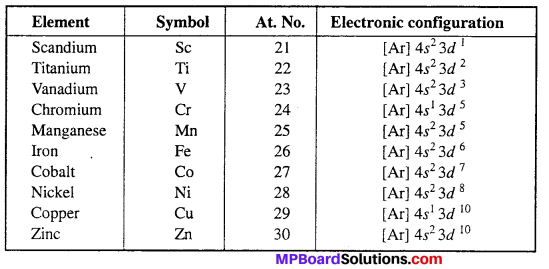
Question 19.
Write general electronic configuration of f-block elements. Write any two uses of lanthanides. Write any two uses of Actinides.
Answer:
General outer electronic configuration of f-block element is :
(n – 2)f1-14 (n – 1)d0-1 ns2.
Uses of Lanthanides : 1. Alloys of lanthanides are called mischmetals and it is used in manufacture of heat resistant, stainless and instrumental steel.
2. Lanthanides compounds are used in ceramic industry, paints, textile industry.
Uses of Actinides : 1. Compound of Thorium are used in cancer treatment.
2. Uranium are used for nuclear energy and its compounds are used in ceramic, medicine etc.
Question 20.
Write uses of KMnO4 and K2Cr2O7.
Answer:
Uses of KMnO4 :
- As a disinfectant for water.
- As an oxidizing agent in the laboratory and industry.
- For qualitative detection of halides, oxalates, sulphites etc.
Uses of K2Cr2O7:
- In calico printing and dyeing.
- As an oxidizing agent.
- In chrome tanning in lather industry.
- In volumetric analysis, it is used in the estimation of ferrous and iodides in redox titration.
Question 21.
Why generally Zn, Cd and Hg are not considered as transition elements ?
Answer:
The atom or ion of an element having incomplete d-orbital is called transition element. On the basis of this definition Zn, Cd and Hg which have complete d-orbital should not be included in J-block elements infact these elements do not resemble d-block in a number of properties, even then these elements are included in d-block element therefore Zn, Cd and Hg are called non-typical transition elements while rest of all transition elements are called typical elements.
Question 22.
Explain Cu+ is colourless while Cu+2 is coloured.
Answer:
If a transition metal contain unpaired electron, it shows paramagnetism and forms coloured compound. In Cu+ d-orbital is partially filled (3d9) thus Cu+ is colourless and diamagnetic while Cu+2 is coloured and paramagnetic.
![]()
Question 23.
What are transition elements ? In how many series they are divided ? Explain.
Answer:
In modern periodic table elements present between 5-block and p-block elements are called transition elements or elements having partially filled d-orbitals are called transition elements. These are known as d-block elements because last electron enters the d-orbitals e.g., Iron (Fe), Chromium (Cr).
Division of d block → Elements of this block has been divided into four series :
(i) First transition series or 3d series → These elements have last electrons in 3d subshell. These series contain 10 elements from atomic number 21 to 30 in fourth period. i.e.

(ii) Second transition series or 4d series → This series include 10 elements from atomic number 39 to 48 in fifth period. The last electron enters in 4d orbitals.

(iii) Third transition series or 5d series → This series also contain 10 elements of 6th period from atomic number 57, 72 to 80. The last electron’ enters in 5d orbitals e.g.
![]()
Elements between La (57) and Hf (72) i.e. from Ce (58) to Lu (71) are called lanthanides or inner transition elements.
(iv) Fourth transition series or 6d series → This series is incomplete. It starts with Actinium (89). Elements between Actinium (89) and Meitnerium (109) are called as Acti-nides. The last electron enters in 6d orbitals, e.g.

![]()
The d-and f-Block Elements Long Answer Type Questions
Question 1.
Giving the electronic configuration of Lanthanide, explain their oxidation state.
Answer:
Lanthanide series : In this series electrons are filled in 4f-sub-shell. Normal electronic configuration of these electrons are (n-2)f1 to 14 (n-1)0 to 1 ns2. Total number of lanthanides are 14 which start from atomic number 58 (Cerium) to atomic number 71 (Lutetium). The main characteristics of this series are following :
Oxidation state: Highest oxidation state of lanthanides is (+3). It is due to loss of 2s electron and one d electron in La. Electronic configuration of La3+ is similar to Xe = 54, which is most stable. Some elements also show +2 and +4 oxidation state because these elements losing 2 or 4 electrons get stable configuration of f7 or f14 e.g., Ce4+(4f1), Tb+(4f8),Er2+(4f11),Yb2+(4f13) but Sm2+,Tm2+ are the exceptions.
Normally +4 oxidation state of lanthanides act as strong oxidizing agent. Like Ce+4 is a good oxidant of aqueous solution which changes to +4 and +3. On the other side +2 oxidation state of lanthanides act as strong reductant. Like Sm2+, Eu2+ and Yb2+ ions, are good reductants which get oxidized in aqueous solution from +2 to +3.
Chemical reactivity : Initial members of this series are highly reactive with the in-crease in atomic number reactivity decreases and are less reactive like Al of high atomic number. Lanthanides react with H2 at 575-675 K temperature forming LaH3. They react with C, X2,O2 and S to form carbide (M2O3 and M2S3), oxide and sulphide. Maximum compounds show +3 oxidation state but some elements also exhibit +2 and +4 oxidation state. On reacting with water, oxides of lanthanides form insoluble hydroxide. These oxides are stronger base than Al(OH)3 but weaker base than Ca(OH)2. These hydroxides react with CO2 to form carbonate.
![]()
Question 2.
Explain the oxidizing property of KMnO4 in acidic, neutral and alkaline medium giving two examples each.
Answer:
KMnO4 acts as strong oxidizing agent in acidic, neutral and alkaline medium.
In acidic medium: It oxidizes in presence of dilute H2SO4 and get reduced.
2KMnO4 + 3H2SO4 → K2SO4 + 2MnSO4 + 3H2O + 5[O]
e.g., (i) It oxidizes ferrous salt into ferric salt,

(ii) It oxidizes oxalate to CO2 :
2KMnO4 + 3H2SO4 + 5C2H2O4 → K2SO4 + 2MnSO4 + 8H2O + 10CO2
(iii) It oxidizes iodide ion to iodine :
2KMnO4 + 10KI + 8H2SO4 → 6K2SO4 + 2MnSO4 + 8H2O + 5I2
(iv) It oxidizes nitrites to nitrates :
2KMnO4 + 3H2SO4 + 5NaNO2 → 2MnSO4 + K2SO4 + 5NaNO3 + 3H2O
In neutral medium: In this medium, the reaction begins with neutral ethylene glycol but this does not give neutral reaction because KOH formed in the reaction makes basic in nature.
2KMnO4 + H2O → 2KOH + 2MnO2 + 3[O]
e.g., (i) It oxidizes manganous sulphate to manganese dioxide.
2KMnO4 + 3MnSO4 + 2H2O → 5MnO2 + K2SO4 + 2H2SO4
(ii) It oxidizes hydrogen sulphide to sulphur.
2KMnO4 + 4H2S → 2MnS + K2SO4 + 4H2O + S
In alkaline medium : In alkaline medium, reduces to MnO2 and gives 3 nascent oxygen.
e.g., (i) It oxidizes ethylene to ethylene glycol.

(ii) It oxidizes iodide to iodate.
2 KMnO4 + H2O + KI → 2 MnO2 + 2 KOH + KIO3
Potassium iodate
KMnO4 gives more number of nascent oxygen in acidic medium than in alkaline medium due to which it acts as stronger oxidizing agent in acidic medium.
Uses of KMnO4: (i) As an oxidizing agent or as Baeyer’s solution in laboratory and industry.
(ii) In the manufacture of saccharin, benzoic acid, etc.